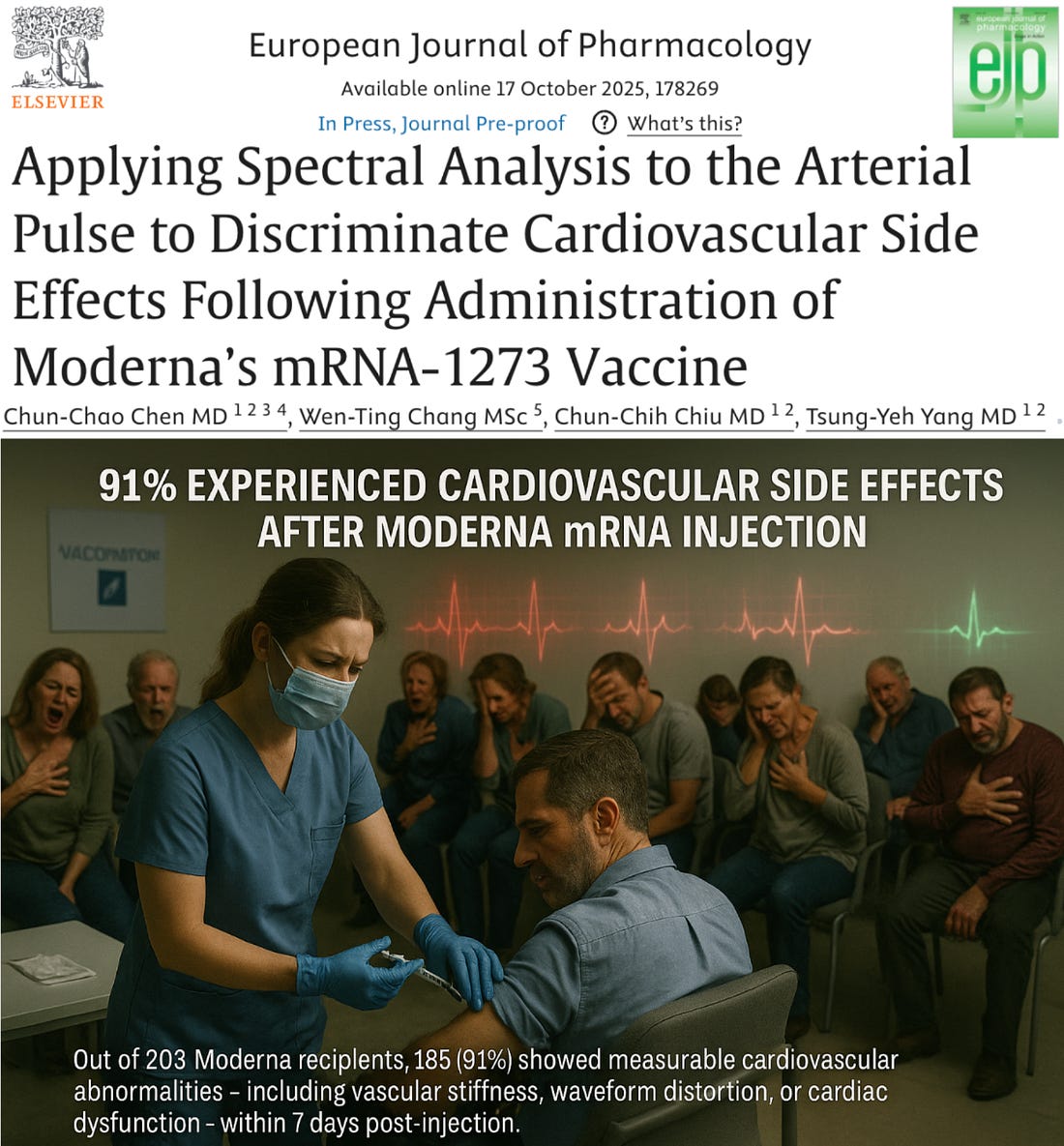
Spectral pulse-wave analysis revealed significant post-vaccine cardiovascular dysfunction consistent with increased arterial stiffness and impaired vascular function.
A new peer-reviewed paper from Taipei Medical University has reported that 91% of Moderna mRNA-1273 recipients developed cardiovascular side effects during the observation period—within one week of receiving the Moderna mRNA-1273 vaccine.
Using advanced spectral pulse-wave analysis, the researchers detected statistically significant post-vaccine changes in arterial pulse amplitude and phase — patterns consistent with arterial dysfunction and increased vascular stiffness.
These were objective, quantifiable changes in how the arteries function — the same alterations seen in hypertension, reduced vascular elasticity, and early endothelial stress.
The study measured the radial pulse wave — the tiny pressure wave your heartbeat sends through your arteries — in 203 adults before and after Moderna vaccination.
Researchers used a computer model to break down each pulse into harmonic frequencies, like separating a sound wave into musical notes.
They analyzed:
Amplitude (Cn): how strongly arteries expand with each beat
Phase (Pn): how synchronized the pulse wave is as it travels through the vascular system
Variability (CVn): how stable the body’s cardiovascular regulation is
These are sensitive markers of vascular health used in early heart disease detection.
KEY FINDINGS
185 of 203 participants (91%) experienced cardiac, vascular, or combined cardiovascular side effects following Moderna mRNA-1273 vaccination.
Statistically significant post-vaccination changes in spectral pulse-wave indices (Cn and Pn) were detected in participants reporting cardiac or vascular side effects.
These changes were consistent with increased vascular stiffness and reduced arterial elasticity, indicating altered blood-flow dynamics after Moderna’s mRNA-1273 vaccination.
No significant differences were observed between groups before vaccination, confirming the changes appeared after the Moderna shot.
Measurements taken 7 ± 3 days post-injection showed the alterations persisted at least one week.
Standard clinical tests (ECG, blood counts, chest X-ray) remained normal in many participants, indicating these were subclinical, measurable vascular changes.
The authors concluded that Moderna’s mRNA vaccine “caused a local mismatch between vascular elastic properties,” likely due to inflammation and immune activation in the vessel wall.
The study explicitly cites spike protein–driven endothelial inflammation, platelet activation, and autoimmune mimicry as plausible mechanisms.
IMPLICATIONS
Subclincial Heart Injury
Even “healthy” recipients without obvious side effects showed quantifiable cardiovascular dysfunction.
This suggests that standard blood tests and ECGs may miss early or subtle vascular changes detectable by spectral pulse analysis.
Cumulative Risk
Repeated exposure to spike-producing injections could amplify these vascular changes over time.
Early Detection Tool
The authors note that this non-invasive technique could be adapted for real-time monitoring of vascular stress following mRNA vaccination.
The authors concluded:
Subclinical vascular changes induced by Moderna’s mRNA-1273 vaccine could be effectively detected by noninvasive real-time pulse distribution analysis.
Translation: Even if you feel fine after the shot, your arteries might tell a different story.
Finish reading: https://open.substack.com/pub/petermcculloughmd/p/new-study-91-of-moderna-mrna-shot
